January 2019 lunar eclipse
A total lunar eclipse occurred on January 21, 2019 UTC (Coordinated Universal Time). For observers in the Americas, the eclipse took place between the evening of Sunday, January 20 and the early morning hours of Monday, January 21. For observers in Europe and Africa, the eclipse occurred during the morning of January 21. The Moon was near its perigee on January 21 and as such can be described as a "supermoon".[1]
| Total lunar eclipse January 21, 2019 | |
|---|---|
_(cropped).jpg) The eclipse seen from Oria, Italy, at 5:43 UTC, January 21, at the end of totality | |
Ecliptic north up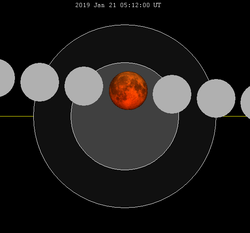 The moon will pass west to east (right to left) through the Earth's shadow. | |
| Saros (and member) | 134 (27 of 73) |
| Duration (hr:mn:sc) | |
| Totality | 1:01:59 |
| Partial | 3:16:45 |
| Penumbral | 5:11:30 |
| Contacts (UTC) | |
| P1 | 2:36:30 |
| U1 | 3:33:54 |
| U2 | 4:41:17 |
| Greatest | 5:12:16 |
| U3 | 5:43:16 |
| U4 | 6:50:39 |
| P4 | 7:48:00 |
As this supermoon was also a wolf moon (the first full moon in a calendar year), it was referred to as a "super blood wolf moon"; blood refers to the typical red color of the Moon during a total lunar eclipse.[2] This was the last total lunar eclipse until May 2021.
The Griffith Observatory in Los Angeles, California captured video showing a meteor between the size of an acorn and tennis ball impacting the moon during the eclipse.[3] The impact was observed during totality, at 4:41 UTC, on left side of the moon.[4] It is one of the only documented cases of lunar impact during a total lunar eclipse.[5][6]
Visibility
The eclipse was visible in its entirety from North and South America, as well as portions of western Europe and northwest Africa. From locations in North America, the eclipse began during the evening hours of January 20. Observers at locations in Europe and much of Africa were able to view part of the eclipse before the Moon set in the early morning (pre-dawn) hours of January 21.
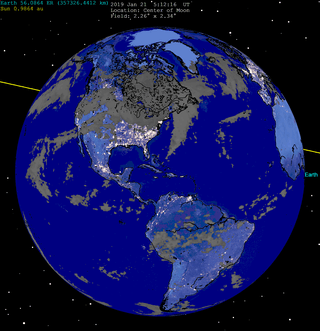 Simulated view of Earth from Moon during greatest eclipse, with infrared clouds |
 Visibility map |
Timing
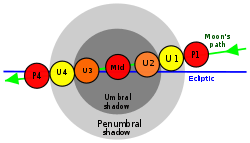

The timing of total lunar eclipses are determined by its contacts:[7]
- P1 (First contact): Beginning of the penumbral eclipse. Earth's penumbra touches the Moon's outer limb.
- U1 (Second contact): Beginning of the partial eclipse. Earth's umbra touches the Moon's outer limb.
- U2 (Third contact): Beginning of the total eclipse. The Moon's surface is entirely within Earth's umbra.
- Greatest eclipse: The peak stage of the total eclipse. The Moon is at its closest to the center of Earth's umbra.
- U3 (Fourth contact): End of the total eclipse. The Moon's outer limb exits Earth's umbra.
- U4 (Fifth contact): End of the partial eclipse. Earth's umbra leaves the Moon's surface.
- P4 (Sixth contact): End of the penumbral eclipse. Earth's penumbra no longer makes contact with the Moon.
The penumbral phases of the eclipse changes the appearance of the Moon only slightly and is generally not noticeable.[8]
| Time zone adjustments from UTC |
Americas | Atlantic | European/African | ||||||||||
|---|---|---|---|---|---|---|---|---|---|---|---|---|---|
| -8h | -7h | -6h | -5h | -4h | -3h | -2h | -1h | 0h | +1h | +2h | +3h | ||
| PST | MST | CST | EST | AST | GMT WET |
WEST CET BST |
CEST EET MSK−1 |
FET MSK EAT | |||||
| Event | Evening January 20 | Morning January 21 | |||||||||||
| P1 | Penumbral begins* | 6:37 pm | 7:37 pm | 8:37 pm | 9:37 pm | 10:37 pm | 11:37 pm | 12:37 am | 1:37 am | 2:37 am | 3:37 am | 4:37 am | 5:37 am |
| U1 | Partial begins | 7:34 pm | 8:34 pm | 9:34 pm | 10:34 pm | 11:34 pm | 12:34 am | 1:34 am | 2:34 am | 3:34 am | 4:34 am | 5:34 am | 6:34 am |
| U2 | Total begins | 8:41 pm | 9:41 pm | 10:41 pm | 11:41 pm | 12:41 am | 1:41 am | 2:41 am | 3:41 am | 4:41 am | 5:41 am | 6:41 am | 7:41 am |
| Mid-eclipse | 9:12 pm | 10:12 pm | 11:12 pm | 12:12 am | 1:12 am | 2:12 am | 3:12 am | 4:12 am | 5:12 am | 6:12 am | 7:12 am | 8:12 am | |
| U3 | Total ends | 9:43 pm | 10:43 pm | 11:43 pm | 12:43 am | 1:43 am | 2:43 am | 3:43 am | 4:43 am | 5:43 am | 6:43 am | 7:43 am | 8:43 am |
| U4 | Partial ends | 10:51 pm | 11:51 pm | 12:51 am | 1:51 am | 2:51 am | 3:51 am | 4:51 am | 5:51 am | 6:51 am | 7:51 am | 8:51 am | 9:51 am |
| P4 | Penumbral ends* | 11:48 pm | 12:48 am | 1:48 am | 2:48 am | 3:48 am | 4:48 am | 5:48 am | 6:48 am | 7:48 am | 8:48 am | 9:48 am | 10:48 am |
Observations
America
.jpg) Austin, Texas, 3:57 UTC
Austin, Texas, 3:57 UTC.jpg) Seattle, Washington, 4:27 UTC
Seattle, Washington, 4:27 UTC Lindsborg, Kansas, 4:40 UTC
Lindsborg, Kansas, 4:40 UTC Buenos Aires, Argentina, 4:40 UTC
Buenos Aires, Argentina, 4:40 UTC San Diego, California, 4:41 UTC
San Diego, California, 4:41 UTC.jpg) Tres Piedras, New Mexico, 4:42 UTC
Tres Piedras, New Mexico, 4:42 UTC Chihuahua City, Mexico, 4:44 UTC
Chihuahua City, Mexico, 4:44 UTC Chapel Hill, North Carolina, 5:02 UTC
Chapel Hill, North Carolina, 5:02 UTC Denver, Colorado, 5:03 UTC
Denver, Colorado, 5:03 UTC Totality in Coralville, Iowa, 5:07 UTC (23:07 Local Time)
Totality in Coralville, Iowa, 5:07 UTC (23:07 Local Time).jpg) Macon, Georgia, 5:18 UTC
Macon, Georgia, 5:18 UTC Whitpain Township, Pennsylvania, 5:26 UTC
Whitpain Township, Pennsylvania, 5:26 UTC.jpg) New York City, New York, 5:37 UTC
New York City, New York, 5:37 UTC Animation from São Paulo, Brazil
Animation from São Paulo, Brazil
Impact sighted
Livestreams detected a flash of light while viewing the eclipse. It was "likely caused by the crash of a tiny, fast-moving meteoroid left behind by a comet."[5]
Originally thinking it was electronic noise from the camera, astronomers and citizen scientists shared the visual phenomenon with each other to identify it.[5]
When totality was just beginning at 4:41 UT, the tiny speck of light blinked south of a nearly 55-mile-wide crater in the western part of the moon.[9]
The location of the impact may be somewhere in the lunar highlands, south of Byrgius crater, according to Justin Cowart, a graduate student in geosciences at Stony Brook University in New York who first saw the flash of light.[5]
“A [meteoroid] about this size hits the moon about once a week or so,” said Cowart.[9]
This may be the first time that a collision, during a total lunar eclipse, was captured on video.[5]
“I have not heard of anyone seeing an impact like this during a lunar eclipse before,” said Sara Russell, a professor of planetary sciences at the Natural History Museum in London.[5]
People posted their images and video of a flicker of light as news spread quickly on social media.[9]
Working overtime, co-director of the Moon Impacts Detection and Analysis System, MIDAS, an astrophysicist at the University of Huelva in Spain, Jose Maria Madiedo, set up eight telescopes to watch for any impacts during the eclipse.[9]
“Something inside of me told me that this time would be the time,” said Madiedo.[9]
A paper estimates a mass between 20 and 100 kilograms and diameter of 30 to 50 cm and could cause a 7–15 meters crater.[10] Other astronomers estimated a 10-15 meter crater from a 45 kg asteroid moving 61,000 km/h.[11]
Related eclipses
Eclipses of 2019
- A partial solar eclipse on January 6.
- A total lunar eclipse on January 21.
- A total solar eclipse on July 2.
- A partial lunar eclipse on July 16.
- An annular solar eclipse on December 26.
Lunar year series
| Lunar eclipse series sets from 2016–2020 | ||||||||
|---|---|---|---|---|---|---|---|---|
| Descending node | Ascending node | |||||||
| Saros | Date | Type Viewing |
Gamma | Saros | Date Viewing |
Type Chart |
Gamma | |
| 109 | 2016 Aug 18 |
Penumbral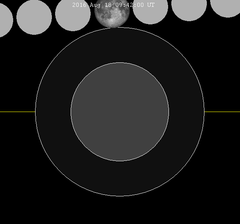 |
1.5641 | 114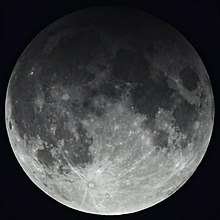 |
2017 Feb 11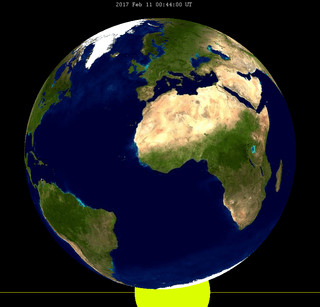 |
Penumbral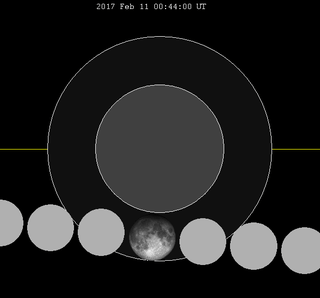 |
-1.0255 | |
119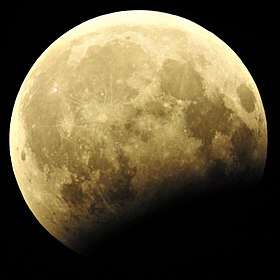 |
2017 Aug 07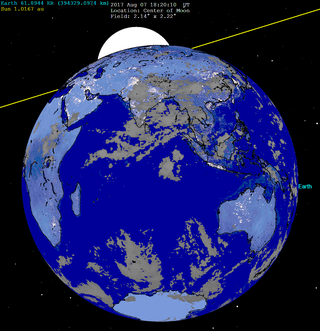 |
Partial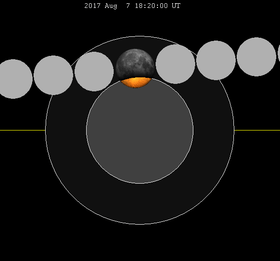 |
0.8669 | 124 |
2018 Jan 31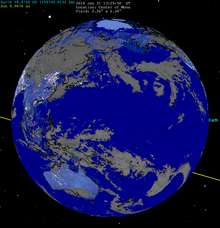 |
Total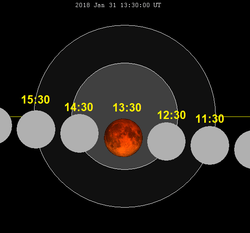 |
-0.3014 | |
129_(43696968392)_(cropped).jpg) |
2018 Jul 27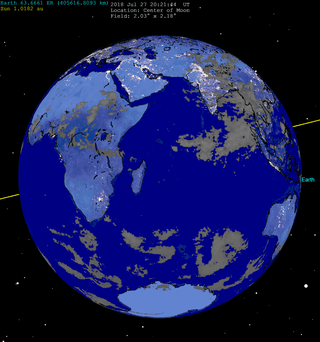 |
Total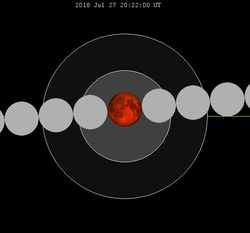 |
0.1168 | 134_(cropped).jpg) |
2019 Jan 21 |
Total |
0.3684 | |
139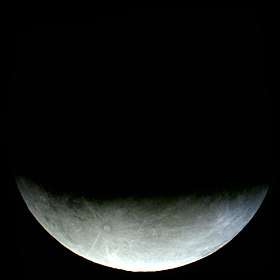 |
2019 Jul 16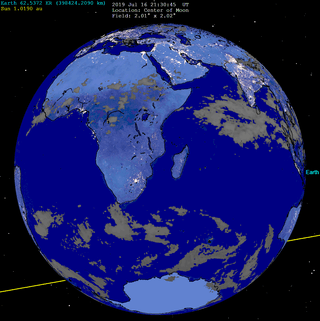 |
Partial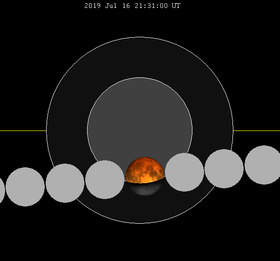 |
-0.6430 | 144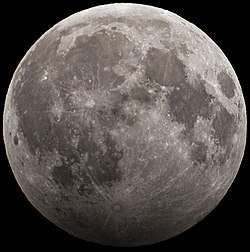 |
2020 Jan 10 |
Penumbral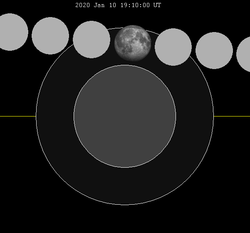 |
1.2406 | |
| 149 | 2020 Jul 05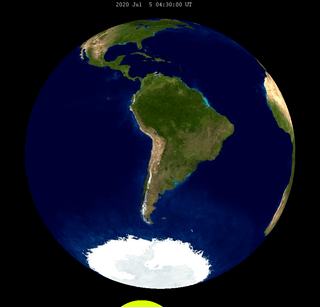 |
Penumbral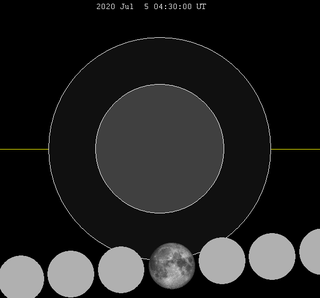 |
-1.3639 | |||||
| Last set | 2016 Sep 16 | Last set | 2016 Mar 23 | |||||
| Next set | 2020 Jun 05 | Next set | 2020 Nov 30 | |||||
Saros series
It is part of Saros cycle 134.
Half-Saros cycle
A lunar eclipse will be preceded and followed by solar eclipses by 9 years and 5.5 days (a half saros).[12] This lunar eclipse is related to two annular solar eclipses of Solar Saros 141.
| January 15, 2010 | January 26, 2028 |
|---|---|
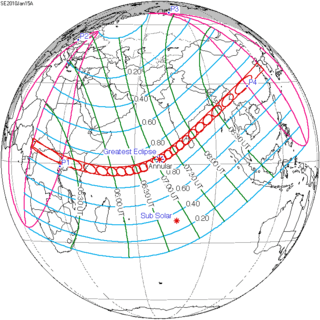 |
 |
See also
- List of lunar eclipses and List of 21st-century lunar eclipses
References
- Rogers, James (20 January 2019). "'Super blood Moon' eclipse stuns in remarkable pictures". Fox News.
- "Super blood wolf moon: stargazers battle cold and clouds to view lunar eclipse". The Guardian. 21 January 2019. Retrieved 21 January 2019.
- Meghan Bartels (22 January 2019). "Watch a Meteor Smack the Blood Moon in This Lunar Eclipse Video". Space.com. Retrieved 22 January 2019.
- "A meteor hit the moon during the lunar eclipse. Here's what we know". Science & Innovation. 22 January 2019.
- Andrews, Robin George (23 January 2019). "During the Lunar Eclipse, Something Slammed Into the Moon". The New York Times. ISSN 0362-4331. Retrieved 23 January 2019.
- "Video: A Meteorite Hit the Moon During the Recent Eclipse!". Jason Kottke. 23 January 2019.
- Clarke, Kevin. "On the nature of eclipses". Inconstant Moon. Cyclopedia Selenica. Retrieved 19 December 2010.
- Espenak, Fred. "Lunar Eclipses for Beginners". MrEclipse. Retrieved 7 April 2014.
- "A meteor hit the moon during the lunar eclipse. Here's what we know". 22 January 2019. Retrieved 24 January 2019.
- Location, orbit and energy of a meteoroid impacting the moon during the Lunar Eclipse of January 21, 2019
- https://ras.ac.uk/news-and-press/research-highlights/space-rock-hit-moon-61000-kilometres-hour
- Mathematical Astronomy Morsels, Jean Meeus, p.110, Chapter 18, The half-saros
.jpg)
.jpg)
.jpg)


